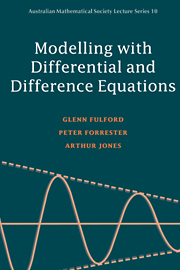Book contents
- Frontmatter
- Contents
- Preface
- Introduction to the student
- Part One Simple Models in Mechanics
- 1 Newtonian mechanics
- 2 Kinematics on a line
- 3 Ropes and pulleys
- 4 Friction
- 5 Differential equations: linearity and SHM
- 6 Springs and oscillations
- Part Two Models with Difference Equations
- Part Three Models with Differential Equations
- Part Four Further Mechanics
- Part Five Coupled Models
- References
- Index
1 - Newtonian mechanics
Published online by Cambridge University Press: 05 June 2012
- Frontmatter
- Contents
- Preface
- Introduction to the student
- Part One Simple Models in Mechanics
- 1 Newtonian mechanics
- 2 Kinematics on a line
- 3 Ropes and pulleys
- 4 Friction
- 5 Differential equations: linearity and SHM
- 6 Springs and oscillations
- Part Two Models with Difference Equations
- Part Three Models with Differential Equations
- Part Four Further Mechanics
- Part Five Coupled Models
- References
- Index
Summary
The aim of mechanics is to explain and predict the motion of bodies. Early in the history of mankind the motion of celestial objects — sun, moon, stars, planets, comets — became a source of curiosity and wonder. At the terrestrial level, questions arising from the motion of falling bodies and of projectiles — whether stones or arrows — attracted the interest of some of the greatest thinkers of antiquity.
The system of mechanics devised by Newton in the seventeenth century made it possible to explain, for the first time, motion of both celestial and terrestrial objects with the one set of postulates, or laws. Newtonian mechanics proved to be one of the most successful mathematical models ever devised and it showed conclusively the value of mathematics in understanding nature. For these reasons, its advent is generally regarded as one of the turning points in the history of human thought.
This chapter introduces Newton's laws and sets them against the background of the set of postulates for mechanics due to the ancient Greek philosopher Aristotle. It also refers to the results discovered by Galileo and Kepler, which showed the inadequacy of the model proposed by Aristotle and thereby set the stage for Newton.
The outstanding success of Newtonian mechanics should not be allowed to blind us to the fact that it is only a model of what really happens. In the present century it has been found inadequate to explain motion at the subatomic level and at speeds close to that of light, which occur in astronomy.
- Type
- Chapter
- Information
- Modelling with Differential and Difference Equations , pp. 7 - 20Publisher: Cambridge University PressPrint publication year: 1997

